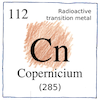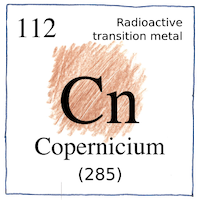Darmstadt—Sigurd Hofmann,
Victor Ninov,
Fritz Peter Heßberger,
Peter Armbruster,
H. Folger,
Gottfried Münzenberg,
H. J. Schött
elements

|
Copernicium
The team at Darmstadt bombarded lead-208 with nuclei of zinc-70 and detected a single atom of copernicium-277, assuming one stray neutron. By this time, the arithmetic was clear to everyone. Given that stray neutron, they might have produced a single atom of copernicium-278, but that must have been an especially slippery neutron.
Atomic number 112
Controversy about the decay chain of compernicuim delayed confirmation of its discovery until 2009. Copernicium is expected not to behave exactly like a heavier zinc, cadmium, or mercury “due to relativistic effects,” In heavier elements, electrons in atomic orbitals travel at a significant fraction of the speed of light, doing strange things to the chemistry.
Impractical uses
So few atoms have been synthesized, and hardly more than one at a time, and they decay so quickly, that the chemistry of copernicium and its state at room temperature are speculative. It would certainly be impractical to try to power a wristwatch with the element. Even if enough copernicium could be synthesized, the cost of copernicium mosquito zappers would be prohibitive. Copernicium-powered time-travel and quantum-tunnelling devices are off the table.



In heavier elements, electrons in s and p atomic orbitals travel at a significant fraction of the speed of light, which increases the relativistic mass of those electrons.
See also in The book of science:
Readings in wikipedia:
Other readings: